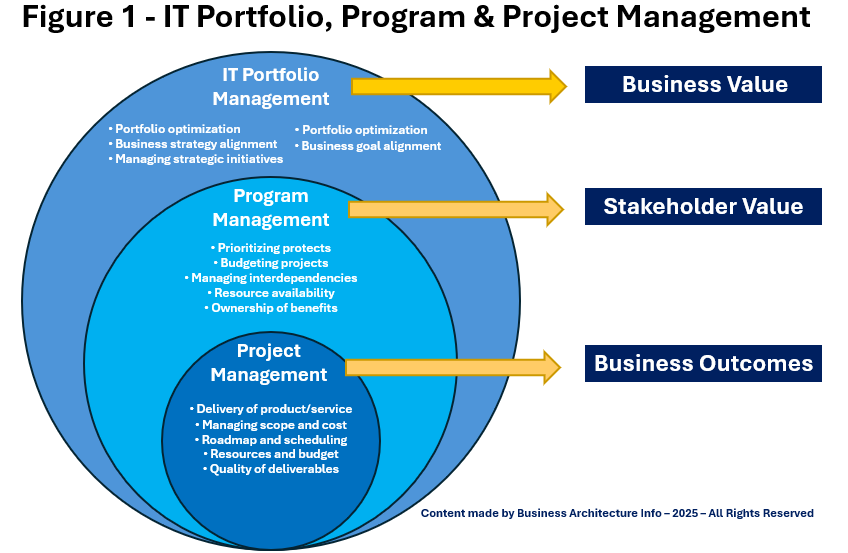Leveraging Enterprise Architecture in IT Portfolio Management
by Daniel Lambert
In today’s fast‑paced business landscape, enterprise architects (EAs) hold a pivotal position in steering organizational priorities, ensuring that technology investments are not just reactive “nice‑to‑have” projects but strategic enablers that directly support business goals. Through structured frameworks, governance, and continuous evaluation, EAs optimize IT portfolios to deliver measurable value consistently.
1. Setting the Context: Why IT Portfolio Management Needs Architecture
IT portfolio management consists of programs and project management, as shown in Figure 1 above. IT portfolios can easily balloon out of control, filled with overlapping initiatives, redundant systems, and low-impact pet projects. But with an EA at the helm, these portfolios become strategically curated collections. EAs begin by:
-
Understanding the enterprise context: Identifying the core problem or opportunity raised by stakeholders and linking it to strategic direction.
-
Defining value streams and capabilities: Mapping out the capabilities that enable key business processes, then understanding the supporting information and technology.
-
Conducting gap analysis: Comparing current and desired states for capabilities, information, and stakeholder readiness. This clarifies where investments are needed most.
From here, the EA crafts a capability release strategy and initiative roadmap, sequencing investment deliverables to generate early impact and phase improvements intelligently.
2. Prioritization: Moving Beyond “Highest Budget → You Just Did It”
With clarity on context and value, EAs employ disciplined prioritization tools:
-
A capability-based roadmap ensures projects align with strategic business capabilities and are sequenced thoughtfully.
-
EAs embed value analysis, scoring initiatives by how much value they deliver versus the cost and effort required, as shown in Figure 2 below entitled “Value–Effort Matrix Project Selection”.
-
When emerging technologies like AI or cloud are involved, architects integrate these through capabilities, as part of a design that avoids capability silos and supports long‑term agility.
This methodical approach protects portfolios from shadow projects and technical debt, letting investments flow where the payback is strongest.

3. Governance: Keeping the Portfolio Honest
Strategy without discipline derails fast. EAs establish governance processes that include:
-
Architecture review boards that validate each project’s alignment to architectural standards and enterprise goals.
-
Formal prioritization frameworks rely on capability impact and outcome metrics to rank initiatives objectively, resulting in a capability-based initiative roadmap.
-
Financial oversight, including ROI projections and “stop‑go” gated investments, is especially critical for high‑risk initiatives like AI.
By embedding EA in governance, the organization ensures accountability, reduces redundancy, and fortifies architecture integrity.
4. Delivery: Bridging Strategy and Execution
EAs don’t just plan. They are also instrumental in delivery:
-
They define the case for change and solution architecture that supports strategic capabilities.
-
They support solution development, overseeing design, integration, and testing—often within agile or iterative cycles.
-
They partner with change managers to embed adoption programs, ensuring that new systems are embraced and impactful.
This ensures that all financed projects are not merely launched, but actually deliver functional outcomes.
5. Continuous Monitoring & Feedback
Once projects are live, EAs maintain oversight to ensure sustained value:
-
They embed monitoring controls, from performance metrics to architectural conformity.
-
They collect stakeholder feedback, using it to identify unwanted complexity or opportunities for iteration.
-
They assess cost-to-value—especially in cloud environments where drift and technical debt can erode ROI—then, when necessary, initiate modernization or retirement activities.
This closed‑loop feedback ensures the portfolio remains fit‑for-purpose and aligned with evolving strategies.
6. Driving Portfolio Agility through Emerging Technologies
Enterprise architects are critical interfaces between IT innovation and business value:
-
AI-driven investment optimization enables smarter resource allocation based on predicted ROI and strategic impact.
-
Capability-based roadmaps—fed by intelligent insights—let portfolios shift in response to market changes.
-
They guide cloud transformation, controlling cost sprawl, ensuring scalable architecture, and managing vendor risks across the portfolio.
With EAs, portfolios evolve from static, finance-driven baskets to dynamic strategic instruments.
7. Building Organizational EA Maturity
Consistent, effective portfolio management demands mature EA practices:
-
Modern maturity models (for example, TOGAF maturity) guide progression from ad‑hoc practices to structured, measurable EA.
-
At top maturity, business capabilities are traced to both business strategy and investment outcomes, providing leaders with data-driven insight into portfolio value.
-
Senior management becomes active participants in EA governance, ensuring alignment across strategy, architecture, and delivery.
This maturity enables portfolios to scale, adapt, and outperform.

Enterprise Architecture - The Backbone of Strategic IT Investment
Enterprise architects are not optional extras. They’re core to effective IT portfolio management and optimization as explained in Figure 3 above. Their role spans as follows:
-
Context & Strategy: EAs frame the problem space, align IT with priorities, and define capability-based direction.
-
Prioritization: They rank investments based on value, cost, and strategic fit, backed by sound frameworks.
-
Governance: EAs ensure architectural integrity and investment discipline through formal approval processes.
-
Execution Support: They design technical solutions, facilitate agile delivery, and drive adoption.
-
Continuous Improvement: Through measurement, feedback, and modernization, they protect and maximize value.
-
Evolution: EAs unlock emerging tech benefits, like AI, cloud, and automation, across the portfolio.
-
Maturity Building: Institutionalizing EA practice scales benefits and strengthens strategic ROI linkages.
In effect, EAs transform the IT portfolio from a loosely managed catalog into a strategic instrument, controlling investment flow, eliminating waste, enabling agility, and driving competitive advantage. Any organization serious about maximizing its IT ROI and remaining adaptable should view enterprise architecture as non-negotiable.

